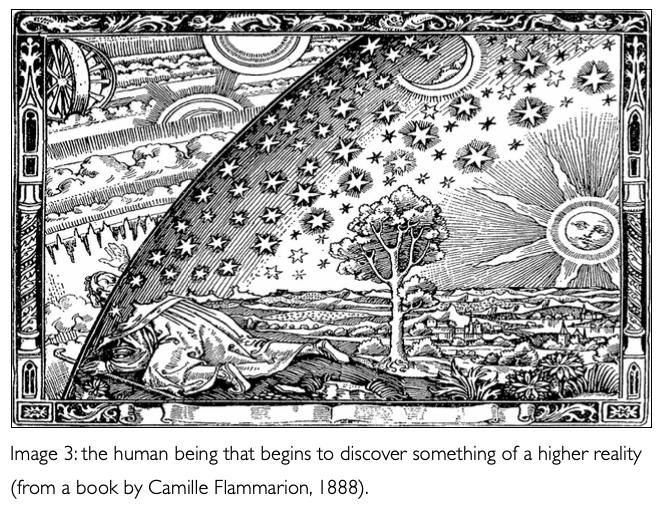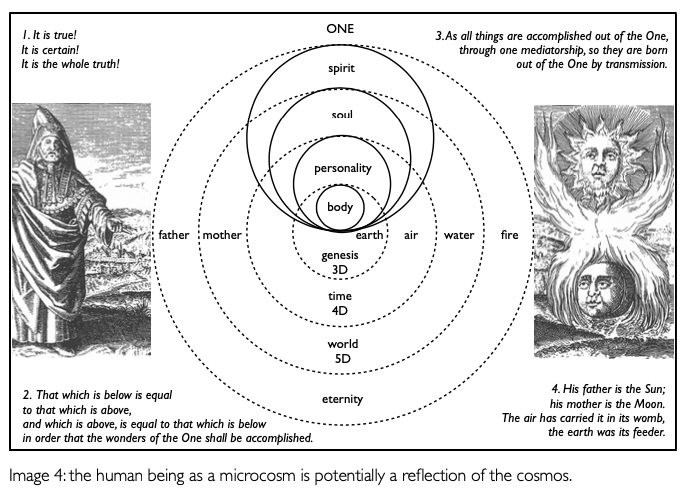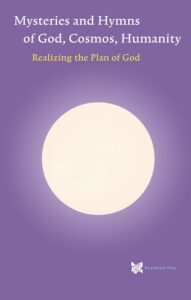Mysteries of God, Cosmos, Humanity, week 2
Reflection: distinguishing dimensions
One of the most common mistakes in religion, philosophy, and spirituality is that a person is considered to be only a body with a personality, and that one fully identifies with that. Obviously these two dimensions of a person are important and they require the necessary attention and care. In authentic religion and spirituality however, the emphasis is specifically put on the awakening of the higher dimensions of oneself, particularly the soul and the spirit, in order to allow them to become more and more active in the personality and in the body. Why? Because only then will you truly become a human being as intended in the divine plan.
In the Corpus Hermeticum, Hermes Trismegistus gives numerous indications for attaining soul consciousness, bwhich rises far beyond what we know so well as our selfconsciousness.
Catharose de Petri (1902-1990), one of the founders of the International School of the Golden Rosycross, writes the following words in chapter 15 of her 1959 booklet ‘The Seal of Renewal’ concerning the relationship between the I-consciousness and the soul-consciousness:
‘The I-conciousness and all that pertains to it is at most a phase in a divine emergency order, serving to lead a fallen microcosm back to his home in the original land of the Father. Whoever wants to maintain his I-consciousness shall perish, that is to say, the turning worldwheel will bring him back to the dialectical starting point, from where he will go up again to the high point in perpetual repetition and so on until … well, until he is ready to “lose his life to find it”, meaning, until he is willing to give up his I-consciousness to find the liberating soul-consciousness. We and all our fellow-men have a soul; this means however, a soulorgan with the activities relating tot it. A soul consciousness is something quite different. He who acquires this soul consciousness has thereby become an entirely different being, a new man, liberated from the world wheel; in the gnostic sense he has become a true Aquarian. It is only then that the love which is in the Gnosis can be fully manifested in him.’
It is gratifying to know that in the 21st century this ancient wisdom, which was vivified in secret by the spiritual schools of all time, is becoming increasingly widespread. The terminology used today is a bit different, but the essence is the same. Those who follow today’s generally respected spiritual leaders on the internet conclude that most people can agree with the statement that man is a multidimensional being and is faced with the task of allowing the higher dimensions to become active within him. Much more so than in the past, this step is now an urgent necessity because the electromagnetic radiation conditions of ‘mother earth’ have changed and have become more intense. As a result of increasing radiation activity, many
people are now more or less forced to go a path of awareness and renewal because they can no longer maintain their old state of being. It is being dismantled.
Increase of the vibration frequency
Contemporary spiritual leaders teach that the increasing activity of a higher dimension should not particularly be looked upon as an increase in volume – as the term dimension might suggest – but instead more as an increase in vibration frequency of the human system. They also disclose that taking part in a higher dimension is not an entirely pleasant process. Since a cleansing and purification of several sorts will need to take place in the body of the person concerned, this process may temporarily cause physical and psychological difficulties.
In this context, one often complains of ‘ascent’ problems.Your more subtle vehicles and your physical body must adapt in order to be able to tolerate more powerful energies. And that takes time. It has always entailed a certain struggle to be able to go a truly spiritual path and to a certain extent it will continue to be so. It is through learning to deal with resistances that we develop inner strength.People who live consciously and conscientiously and strive inwardly sometimes look with amazement at their fellow human beings who are following their natural tendencies,apparently enjoying themselves and leading a pleasant life.Then all kinds of questions may arise, such as why can I not be happy with a regular life? For example: why do I still have problems with health, relationships, work and finances, in spite of my extensive knowledge and experience, and while still honestly doing my best? Should I perhaps give up my entire pursuit for depth and meaning in life in order to experience more joy in my life?
The idea that life should above all be pleasant and entertaining is sometimes called the illness of our time. We will have to accept that life is not always fun and can sometimes even be very burdensome. If you follow the hermetic way, your life can be more enjoyable, but it will not automatically be so. Your life will, however, absolutely be more meaningful. And if you persevere, a breakthrough can take place within yourself whereby the spirit-soul becomes active in your personality. Then each time that you lift yourself up inwardly, you can experience great joy, even if your personal circumstances are far from ideal. As it is sometimes said nowadays, your consciousness is then transformed from ‘3D’ to ‘5D’.
What the School of the Golden Rosycross calls the dialectical consciousness or the I-consciousness is nowadays often referred to as the third-dimensional consciousness or 3D-consciousness. The highest achievable option in this respect is a well-functioning rational mind. There is no room for higher intuition or divine inspiration in 3D. The limited 3D consciousness – connected to the contaminated etheric, astral and mental spheres of the earth – is in particular characterized by fragmentation, conflict and competition, disharmony and separation.
All these qualities are in sharp contrast to the values that apply in the soul world – the fifth dimension or 5D – which is related to living from the heart. According to J. van Rijckenborgh and Catharose de Petri, this living from the heart can be achieved by means of the so-called square of construction: clearly aiming at this goal, living without conflict, maintaining inner harmony and living in and through the All-Unity. The fifth dimension is the field of unconditional love, it is the world of ideas of Plato, it is the Kingdom of Heaven about which Jesus speaks and it is the domain that Hermes Trismegistus refers to as ‘the World’. A person can participate in 5D through soul rebirth, which is an inner Christmas celebration based on transformation of consciousness. This transformation is often symbolized by the five-pointed star, the pentagram. We are steered from many directions to this ascent of consciousness that humanity as a whole is now facing.
Intermediate phase
A question that will inevitably arise from the foregoing is: What then is the fourth dimension or 4D? This phase is an intermediate one between the third dimension and the fifth dimension, and usually lasts considerably longer than most people would like. The human being in the fourth dimension is touched inwardly, knowing from within that there is much more than the sensory perceptible world and that he is called upon to unseal higher dimensions within himself. He is committed and willing to do this, but discovers that he fails again and again because he is still inwardly divided. He tries to live with his 3D consciousness according to the norms of a 5D consciousness. Sometimes it works, but often it goes wrong because his consciousness and his human system have not yet been transformed.
The human condition in this intermediate phase, or 4D, is beautifully depicted in a lithograph from a book by Camille Flammarion (see image 3). A pilgrim sticks his head through the heavenly dome and discovers that behind it there are all sorts of other worlds unknown to him. The image is of course symbolic because in a physical sense there is no heavenly dome at all. The artist knew that of course. But he wanted to depict something that is impossible to express on a horizontal plane, in a three-dimensional space.
The pilgrim on the lithograph is astonished and perhaps also enthusiastic because he experiences something of realities that until now he never thought to exist. It feels good to be enthusiastic about something, because then you experience the life force within yourself and there is joy. The literal meaning of enthusiasm is: to be in God (in theos). And that is exactly what authentic religion and spirituality is all about: being consciously in God. According to hermetic philosophy, everything is in God. Hermes says:
‘So there are these three: God, the Father, The Good; the world; and man. God encompasses the world and the world encompasses man. The world is God’s son; man is the son of the world, God’s grandson, as it were. It is not as if God does not know man. On the contrary, He knows him perfectly and wishes to be known by him’.
(Corpus Hermeticum 12: 42-43)
So here we read that God wants to be known by man, not as a theoretical abstraction or as a working hypothesis, but as a living experience. And therein lies the challenge, because Hermes finds that the greatest sin in people is that they do not know God. He even invites man to become God, for he says, ‘This is the good end for those who possess the gnosis, the knowledge of God, that they become God’. (Corpus Hermeticum 1:65)
Humanity as a whole is still quite far distant from this state. That was already the case in ancient times and it still is today. Therefore the following admonishing words from Hermes are still extremely topical:
‘Whereto are you hurrying, O men, you whose minds are clouded because you are drunk with the word that lacks all Gnosis, the word of absolute ignorance that does not agree with you and that you vomit in the end? Stop and become sober: see again with the eyes of the heart! And if not all of you can do so, let those at least who can. The malignity of ignorance floods over the whole earth, ruins the soul which is penned up in the body and prevents it from reaching
the harbours of salvation.
Look for Him who will take you by the hand and lead you to the gates of the Gnosis, where the lear light shines in which there is no darkness; where no one is drunk, but all are sober and look up with their hearts to Him who wishes to be known. But listen well: His voice cannot be heard and His name cannot be pronounced, nor can material eyes view Him. Only the Spirit-Soul is capable of so doing’ .
(Corpus Hermeticum 3:1-5).
So with our senses and with our normal consciousness we cannot perceive or experience God, or the gnosis. We are invited to start looking again with the eyes of our heart, that is, if we are able to do so. The human view and world view of Hermes differs greatly from that of people who identify themselves completely with their body and their personality. It is stated in hermetic philosophy that there is potentially a soul and a spirit-soul within the human system. Usually they are still latent, and the intention is that they awaken and become active after many earthly lives, on the basis of a fullness of experience and a consciously chosen inner path.
Microcosm
Hermes and many others regard mankind as a reflection of the cosmos, and for this reason is called a microcosm: a miniature depiction of the great cosmos. When we look at night into the cloudless sky with our eyes or with telescopes, then what we observe does not at all resemble a human being: infinite stars and planets in the form of bright spots in an otherwise seemingly empty universe. However this is only the material aspect of the universe, corresponding to our physical body and which Hermes refers to as ‘genesis’.
When Hermes Trismegistus has become silent within and thus opens up to divine inspiration, the spirit-soul who calls himself Pymander begins to speak to him. Because opinions about God are contradictory, Hermes longs for an explanation of God from his innermost self. Pymander then tells Hermes that four spheres can be distinguished and that they have matured from each other: eternity, the world, time and genesis.
Pymander says: ‘God makes eternity, eternity makes the world, the world makes time, and time makes genesis’ (Corpus Hermeticum 2:4). He explains this as follows: ‘Goodness, beauty, blissfulness and wisdom form, as it were, the essence of God; the essence of eternity is invariability; the essence of the world is order; the essence of time is changeability; and the essence of genesis is life and death.’
If we combine this with other information from the hermetic scriptures, we may conceive an abstract image of humanity and of the world, as is shown in image 4. Here we see that the absolute human being, the microcosm, has the same inner structure as the macrocosm in accordance with the hermetic principle ‘as above, so below’. This axiom formed the basis for alchemy as formulated in the Emerald Tablet (hymn 2), a classical hermetic text, as follows: ‘That which is below is equal to that which is above, and that which is above is equal to thatmwhich is below, in order that the wonders of the One shall be accomplished’.
In ancient times, Greek philosophers distinguished four elements: earth, air, water and fire. These are not elements in the form of building materials for physical reality, such as the chemical elements of the periodic table, but are indications of certain qualities that can be experienced. In the human body we recognize the element earth in the solid matter from which it is composed. We recognize the element air in the breath that is characteristic and indispensable for life. The element water is fully present in the human body, with our body consisting of approximately 55 to 60 percent of the substance H2O. In digestion, organic nutrients are converted with the help of oxygen into carbon dioxide, water and energy, which becomes available mostly in the form of work and heat. This process is related to the element of fire.
As above, so below
According to the principle ‘as above, so below’ the classical elements earth, air, water and fire are not only present in the physical body of man, but also in his personality, in his soul and in his spirit-soul. Within the personality we recognize the four elements as follows: the physical body as earth, the etheric body as air, the astral body as water and the mental body as fire. The four elements are also present in the larger structure of the human system: the physical body corresponds to earth, the personality corresponds to air, the soul corresponds to water and the spirit corresponds to fire.
Thus we can understand why Jesus says, ‘If a person is not born of water and spirit, he cannot enter the kingdom of God’ (John 3:5). By being born of water, a transformation of consciousness is meant, and the rebirth from spirit implies that the fire of the holy spirit becomes active in a person with a renewed consciousness. In the human being, not only the body and the personality must be developed, but also the soul and the spirit-soul, because all these aspects are necessary for the human being to be able to participate in the implementation of the divine plan. Among other things, Hermes Trismegistus says the following about this process.
‘The spirit, the most rapid of all divine thought-creations, has for its body also the most rapid of all elements: fire. The spirit, the creator of all things, uses fire as an instrument for its creative work. Thus universal thought creates the All. The thoughts of human beings create only what is of the earth. Since man’s cognitive faculty does not possess a garment of fire, it is not capable of calling into being divine things and is confined by its vehicles to what pertains to man. The human soul – not every soul however, but the soul truly devoted to God – is in a certain sense good-demonic and divine. When such a soul, after having walked the path of true piety – a path that leads to knowledge of what is divine and to refraining from injustice or harm towards any man – has detached itself from the body, it becomes Spirit-Soul throughout’
(Corpus Hermeticum 12:54-56).
Hermes therefore speaks of going the path of devotion to the divine. Although a person has to go that path individually, he cannot accomplish it on his own. That is why Hermes provides the indispensable higher energies to the pupils that he teaches and guides: Tat, Asclepius and Ammon. On this path of awareness and renewal, the natural ensoulment of man is cleansed and purified so that a spiritual inspiration can become active and will gain power over the natural soul substance, thus leading to the re-creation of the entire human system. Through that fundamental change, that transfiguration, man acquires new powers that enable him to cooperate in the realization of the divine plan.
In chapter 1 of the scripture ‘Admonition of the Soul’, Hermes Trismegistus advises his pupils to reflect intensively on the composition of things in order to go the path of sanctification.
‘Soul is more subtle than all the things encompassed by it, inasmuch as they are bodies and elements, but soul is wholly incorporeal. All things that are situated below soul are unable to partake of life except by means of soul. Soul possesses in itself the powers of thought, will, and judgement; and it extends its own properties to all things with which it is conjoined, so far as they are capable of receiving those properties; and thereby they attain to life. But those things with which soul is not conjoined are utterly destitute of thought, will, movement, and judgement; and a thing that does not possess these properties in any degree is lifeless.
Next above the substance of soul comes Spirit, which is exalted above soul, and encompasses it. Spirit is the subtlest of all things discoverable; it is superior to all the rest, and is situated in the highest place.
And Spirit is inferior only to that supreme Deity who is eternal and most holy and most lofty. From Him, without intermediary, does Spirit receive, and dispense to all things placed below it, excellence and light and life Mind is the supreme mediator between God and the Kosmos, the chamberlain who stands nearest to the King. Contemplate this system then, O Soul, assure yourself of its truth, and be firmly convinced of it; for thus it is that things are constituted, ordered, and arranged’.
(Admonition of the Soul, Chapter 1)



